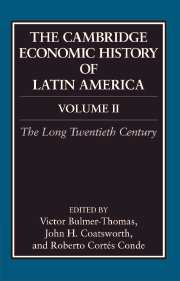Book contents
- Frontmatter
- Introduction
- Part I Cycles of Globalization
- 1 Globalization in Latin America before 1940
- 2 Foreign Capital Flows
- 3 The External Context
- 4 Globalization and the New Economic Model in Latin America
- Part II Onset of Modernization
- Part III Factor Endowments
- Part IV Sectoral Development and Equity
- Bibliographical Essays
- Index
- References
2 - Foreign Capital Flows
from Part I - Cycles of Globalization
Published online by Cambridge University Press: 28 March 2008
- Frontmatter
- Introduction
- Part I Cycles of Globalization
- 1 Globalization in Latin America before 1940
- 2 Foreign Capital Flows
- 3 The External Context
- 4 Globalization and the New Economic Model in Latin America
- Part II Onset of Modernization
- Part III Factor Endowments
- Part IV Sectoral Development and Equity
- Bibliographical Essays
- Index
- References
Summary
To understand the impact of globalization on the developing countries of the periphery, one has to study Latin America. As historians of the area understand, this is the region whose economic fortunes have been most significantly shaped by external forces in the five centuries since the voyages of discovery first made a global economy a distant, but realizable, possibility. Only late in this process, from the nineteenth century, did external capital markets play any major role, but once in place they became important in many dimensions. They served as an engine of growth for the region, changed patterns of income distribution and sectoral growth, and, as a problem of political economy, they prompted complex and ambivalent responses that shaped subsequent development.
The subject of this chapter is capital flows between countries or regions – that is, international investments. Specifically, I consider only their long-term function, focusing on areas other than the needs of trade (i.e., short-term commercial credit) – a topic that is best reserved for discussions on the evolution of international trade. My goal is to document what we know of these flows. For the colonial period, there is not much evidence, but the flows were probably small. In the nineteenth century, when good records begin, the flows increased over time as global capital-market integration increased. Economic growth had fallen behind the core countries in the early 1800s, as the struggles for independence weighed down this peripheral region and the industrial revolution lifted the core. But parts of the region, helped by capital inflows, managed to regain ground in the late 1800s.
- Type
- Chapter
- Information
- The Cambridge Economic History of Latin America , pp. 57 - 100Publisher: Cambridge University PressPrint publication year: 2006
References
- 9
- Cited by

